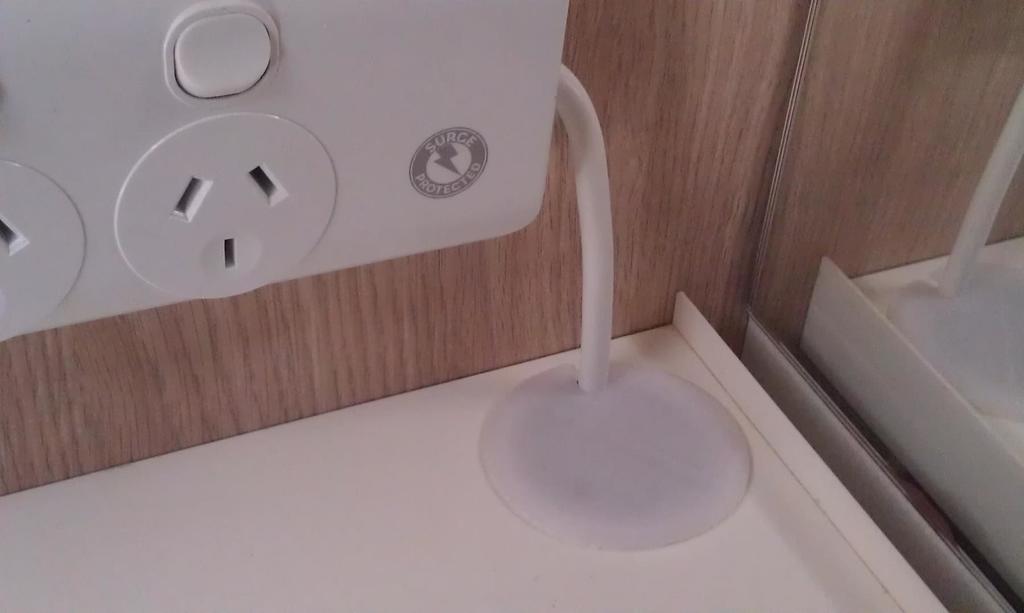
Desk benchtop cable fascia filler plug grommet
thingiverse
I installed a mains powerboard in a caravan and had to cut a hole through a vestibule benchtop. The largest (electric drill) hole cutter saw I had was 50mm and was just enough for the power plug to go through, so I needed to have a filler plug that did not rely on clipping into a ring. This design just fits the hole in the panel or desk directly, and provides support against the cable rather than having a sharp edge of a disc put pressure on it. The script is fully customisable for hole sizes and depths, as well as four styles of plug body, and three choices of flange edge. For my 50mm dia holes I found a printed size of 49mm fitted snugly, depth 10mm and a single 7mm diameter cable slot. This also fitted a factory-cut hole in my caravan's cupboards too. For a desktop filler plate, use the FLUSH TOP option to have a smooth top. For places where it is more difficult to reach into (such as the back of the inside of a cabinet - see photos) use the FINGERGRIP style. I printed one with a flush top for the desk and the rest with grips for internal cabinet partitions. *The options as described below are shown across the annotated diagrams.* These are: **CABLES** How many electrical or other cable cutouts, default is for a single cable. Set to 0 for a sealing plug. **CABLE_DIA** The diameter of the cable. For my powerboard, 7mm was an optimum fit for my application. **HOLE_DIA** The diameter of the hole in your desk, table or bench top. **HOLE_DEPTH** How deep you want the plug to go. 10mm was adequate. (This does not include the top plate thickness) **LIP** Width of the flange around the top of the plug (added to radius). 5mm was fine. **WALL_THICK** Sidewall thickness. 2mm was fine for me. **PLATE_THICK** The top flange plate. The default is the same as wall thickness. **PLATE_EDGE** The style of the flange plate's edge: square, rounded or chamfered. For a thin plate it doesn't matter too much. **INSET** The FLUSH TOP style is for a smooth surface suitable for a desk. The BOTTOM style has a flanged lip at the top, and filled-in floor. The FINGERGRIP style is the same as the bottom style but with a finger grip bar across the plug (like a sink plug). The NONE style has no enclosing surface, just a wall-thickness ring and flange, for air circulation. **FINGERGRIP_WIDTH** How wide you want the grip bar. (Only applicable to FINGERGRIP style) **FINGERGRIP_UNDERSIDE_RECESS** Underside cutout of the grip bar. When printing at 100% infill, saves a solid block being made. **FLEX_SLOTS** Vertical slots through the wall periphery to give some flexing. This is omitted for the bottom and grip styles. **FLEX_GROOVE** An additional reduction of the diameter where the flex slot fingers join the flange. **TIE_LOOP** Add a means of tying a string to the plug. I printed mine from white PETG. This is ok, but I think white ABS would have been more opaque. But, I'm happy with the results. **This script and the models it generates are placed in the Public Domain.** I do not warrant this program nor the models it generates as fit-for-purpose for anything, use entirely at your own risk. There are bugs and limitations to the geometries generated (feel free to fix them), but for many situations it should work fine. As a courtesy please leave my name as the author of the program. Thanks, and I hope you find it useful.
With this file you will be able to print Desk benchtop cable fascia filler plug grommet with your 3D printer. Click on the button and save the file on your computer to work, edit or customize your design. You can also find more 3D designs for printers on Desk benchtop cable fascia filler plug grommet.
